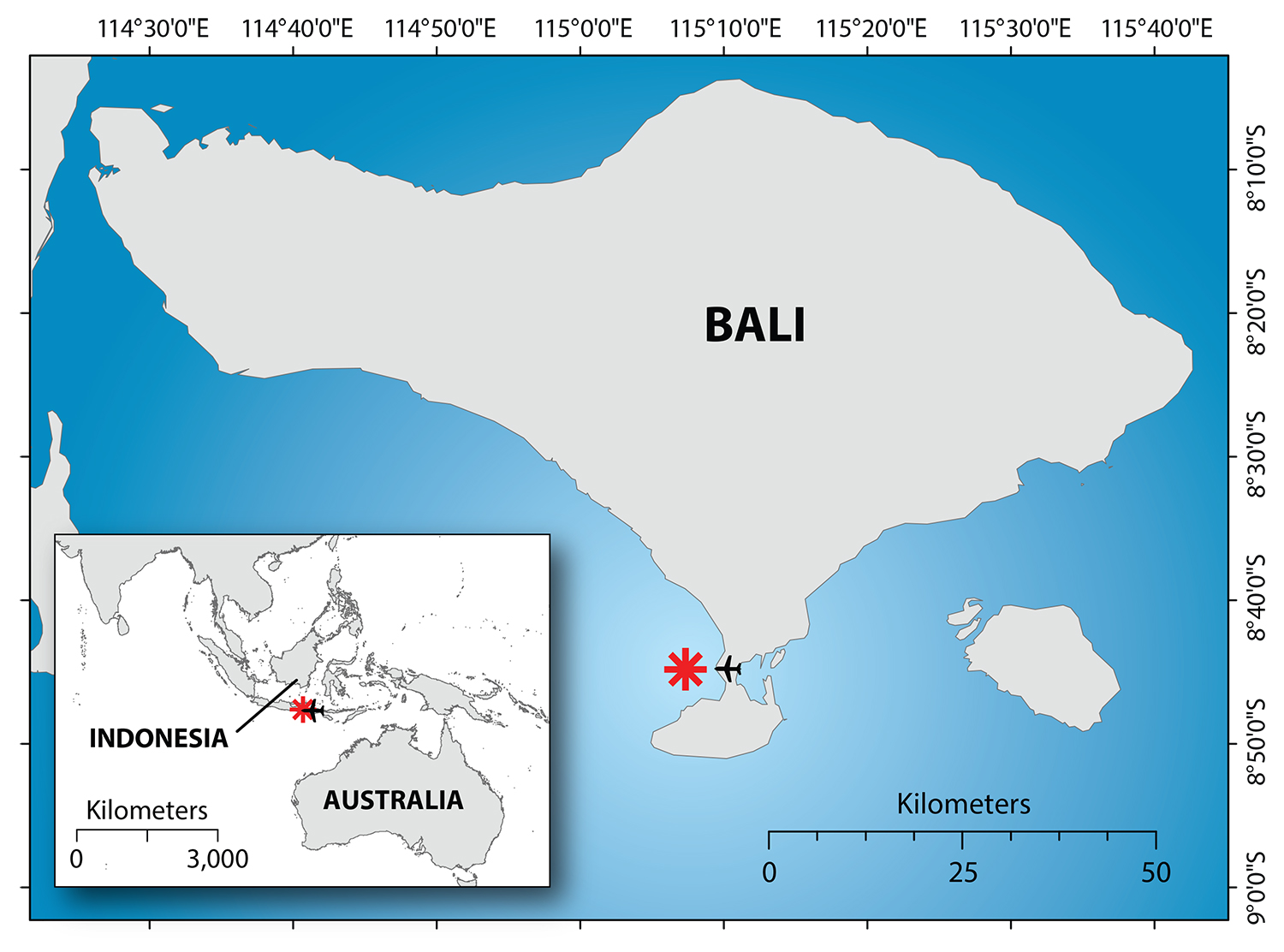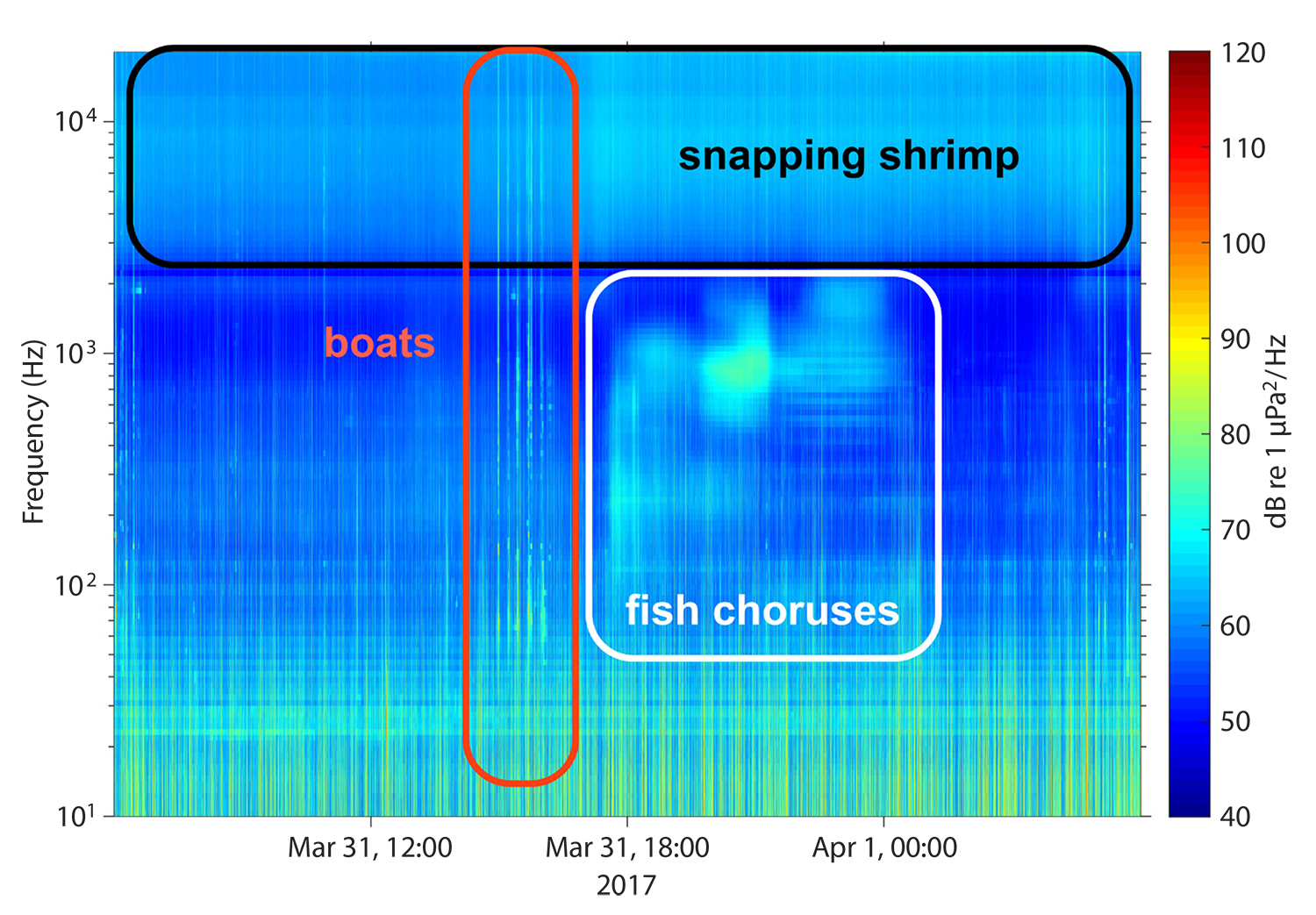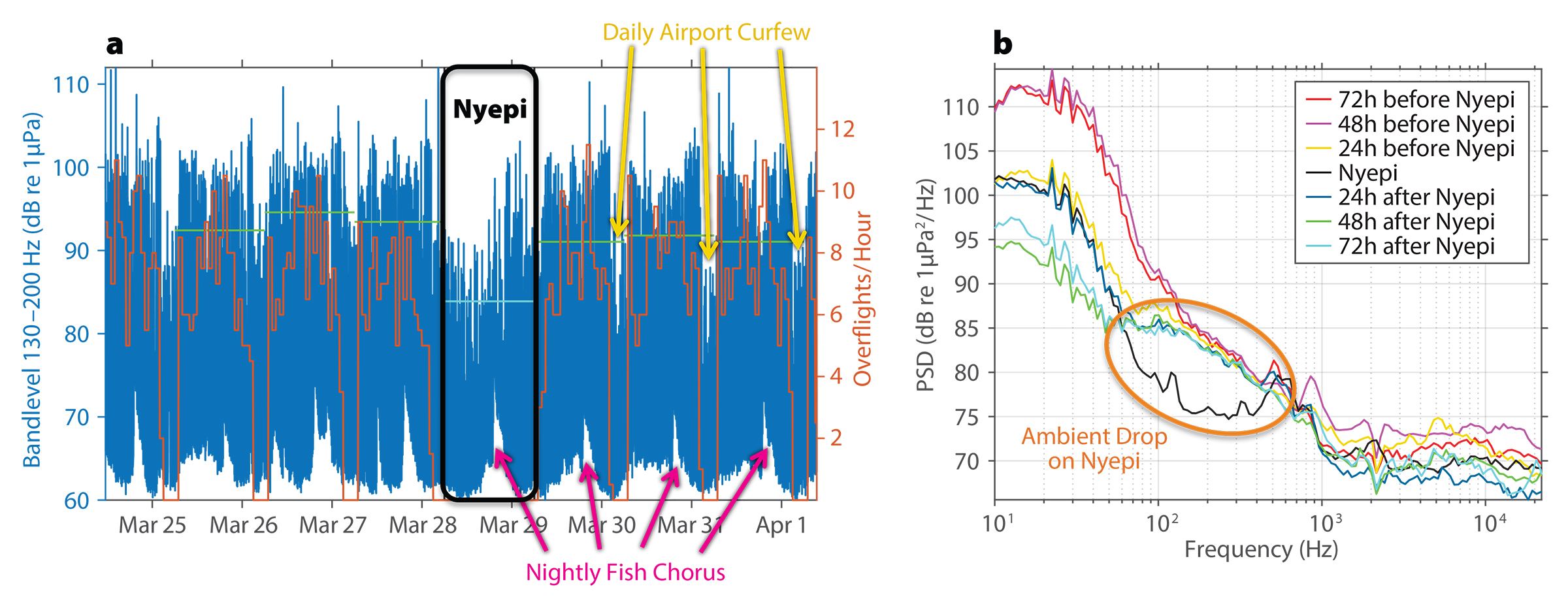Full Text
Taking advantage of a religious holiday called Nyepi that curtailed human activities for one day, we recorded acoustic noise levels for one week in shallow waters of a little-trafficked area west of Bali below the Ngurah Rai airport flight path (Figure 1). Sound is as important to many marine organisms as vision is to humans. From the song of the humpback whale to the exquisite sonar system of the killer whale, many marine vertebrates have evolved sophisticated systems for sending and receiving acoustic signals to facilitate vital life functions. Coral reef fish sing in a dawn chorus, much as songbirds do (McCauley and Cato, 2000).
|
|
Anthropogenic noise is an increasingly dominant feature of the ocean environment, with ship traffic and other human activities causing noise levels to increase in some places by 3 dB per decade (Chapman and Price, 2011; Frisk, 2012). A growing body of literature is characterizing impacts of anthropogenic noise on individual organisms, including invertebrates, fishes, turtles, and marine mammals (Slabbekoorn et al., 2010; Williams et al., 2014, 2015a; King et al., 2015; Erbe et al., 2016). Anthropogenic noise can elicit behavioral responses in marine wildlife, disrupt vital life functions (e.g., feeding or anti-predator vigilance), mask bioacoustic signals, and reduce the range over which biologically important signals can be heard above background noise. Paradoxically, one of the biggest barriers to understanding the impact of ocean noise on marine species and communities is the sheer ubiquitousness of ocean noise. In the face of urbanization and global trade, we are running out of quiet times and places for studying and understanding natural ecological processes and providing control periods and sites to facilitate controlled exposure experiments (Williams et al., 2015b).
The ocean acoustics community recognizes that understanding effects of noise on long-lived, mobile marine species will require large-scale experiments that are logistically daunting. The International Quiet Ocean Experiment (IQOE) is a proposal to coordinate efforts to study acoustic environments and marine organisms during experimental efforts to reduce anthropogenic sound sources temporarily (Boyd et al., 2011). The IQOE approach accepts that logistical challenges may necessitate mounting several experiments to be carried out over long durations at small spatial scales, rather than organizing one grand, global experiment.
Inspired by the IQOE model, we took advantage of a planned day of reduced human activity during Nyepi, a Balinese Day of Silence (Kasa, 2011). This day of introspection precedes the New Year on the Balinese saka lunar calendar. Observed from 6 a.m. one day to 6 a.m. the following day (March 28 to 29 in 2017), Nyepi is devoted to silent meditation, fasting, and self-reflection. On land, all commercial activities cease for 24 hours. The airport and shipping and fishing ports are closed, and wandering tourists are guided back to their hotels. Lights are dimmed, and all work is prohibited. Although Nyepi is a Hindu holiday, restrictions on noise and personal movements apply to non-Hindu residents and tourists alike. We took advantage of Nyepi in 2017 to record noise levels in the waters off south Bali before, during, and after the day of silence.
Despite being able to retrieve data from only one of our six acoustic recorders (see Methods below), the underwater soundscape at our recording site revealed a rich ecological fauna and a range of human activities (Figure 2). Snapping shrimp sounds dominated the 2–48 kHz band day and night for the entire week (though about 3 dB stronger at night). At least four different nightly fish choruses were heard (60 Hz to 3 kHz, 7 p.m. to 2 a.m. daily). Broadband periods indicated bouts of wind and rain. About 10 boat passes were heard each day, mostly during daylight, except on Nyepi. Airplanes flying overhead were audible underwater at 20 Hz to 10 kHz, with about one plane every seven minutes, and no planes from approximately 2 a.m. to 7 a.m. daily, nor throughout Nyepi. There was also mooring noise (up to 100 Hz) at times of strong wind, which is a recording artifact and not part of the wider soundscape.
|
|
We measured a substantial drop in ambient noise levels at anthropogenic frequencies during Nyepi (Figure 3). We see this as a minimum estimate of the effect size one could expect to measure in future IQOE-style experiments. Our effect size was restricted by shallow water (i.e., isolated by poor sound propagation) and the relatively low-traffic conditions in the area (i.e., tens of kilometers from the main shipping lanes). We would expect even greater drops in ocean noise off the southeastern coast of Bali, where ship traffic levels are higher. The 6–10 dB drop we detected on Nyepi in the noisiest ambient levels in the roughly 60–500 Hz band will increase the propagation range of low-frequency signals used by fish and whales for biological signaling. Given no additional information, a 6 dB drop in noise levels in this band will increase propagation range by a factor of two to four, depending on the reflectivity of the seafloor, and will increase communication space (volume) by a factor of 8 to 16 in this shallow-water environment. The drop in noise levels strikes us as sufficiently large that it warrants targeted ecological research to monitor how marine organisms may respond to such an increase in acoustic space. We anticipate that a day of silence may improve the audibility of the fish chorus used in mating, but it may also make the calling fish more readily detectable by predators. The planned nature of Nyepi creates an unusual opportunity to test acoustic trade-offs between predator and prey in future studies.
|
|
The 6 dB drop in anthropogenic noise during Nyepi is substantial. For comparison, Rolland et al. (2012) reported a 6 dB decrease in ambient noise (50–20,000 Hz) in autonomous recordings made in the days when ship traffic dropped following the terrorist attacks on September 11, 2001. They found that whale stress levels fell as ship noise levels dropped. We are motivated by our findings to return to Bali with sufficient resources to sample deeper water, refine our estimates of ocean quieting, and expand our study using visual and acoustic methods to detect responses of marine wildlife to this period of quiet. Many world religions and local cultural traditions honor a sabbath, jubilee, or feast day on which work is prohibited. In light of the daunting challenge of accomplishing an international day of silence, we see value in short studies to conduct remote monitoring in a culturally sensitive way during local holy days in order to estimate how much noise levels drop when people stop working for one day.
Methods
Six autonomous underwater acoustic recorders (SoundTraps from Ocean Instruments New Zealand) were deployed for a week—three days prior to, then on, then three days after Nyepi. Budgetary constraints limited our team to a small boat with professional divers. Of the six deployments, only three SoundTraps could be recovered safely. One of them had mechanical failure and another was accidentally deployed in water too shallow to receive measurable noise from vessels. We obtained high-quality recordings from one site: the little trafficked area west of Bali below the Ngurah Rai airport flight path (8°44'59.14''S, 115°8'37.29''E). The water depth was 11 m. The factory-calibrated SoundTrap (model STD) was deployed 50 cm above the seafloor, tied to a metal frame, and sampled at 96 kHz, 16 bits, for 4 minutes and 40 seconds every 5 minutes. At that location, we were removed from commercial shipping lanes but were well positioned to detect changes in received level due to cessation of small vessel traffic and airplane noise. We obtained detailed flight records for Ngurah Rai airport from FlightAware in order to explore correlations between noise levels and flight traffic patterns.




